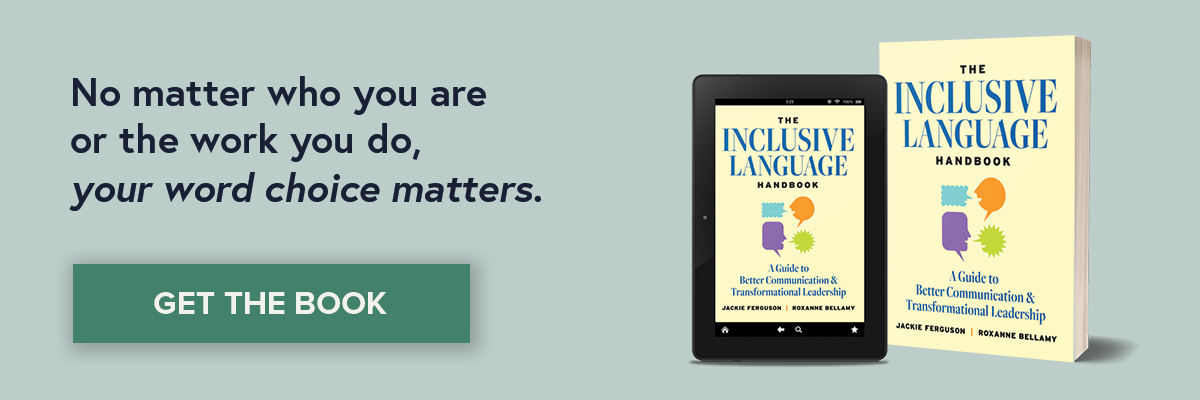Inclusive language…what does it mean? Inclusive language means finding ways to name, honor, and value experiences and identities. But before inclusive language is possible, it is vital to understand the ways that words and expressions can signal assumptions about people and unintentionally reinforce dominant ideas about gender, sexual orientation, race, class, ability and disability, age, and more.
Inclusive language is not the same as being politically correct. Political correctness is focused on not offending whereas inclusive language is focused on honoring people’s identities. While both inclusive language and political correctness certainly posit that there are certain things you should not say, political correctness can create discomfort, which prevents people from engaging. On the other hand, inclusive language allows for more flexibility and connectedness. It is focused on education, dialogue, and naming people in accordance with their personal identities.
There are six primary rules to inclusive language.
1. Put people first.
Focus on the person, not their characteristics. For example, instead of saying, “our millennial sales girl,” say “our salesperson who is female and identifies as a millennial.” People are more than their descriptors, and putting people first maintains the individual as the essential element.
Even though the phrase “our salesperson who is female and identifies as a millennial” is preferable, it is important to note that you should only mention characteristics like gender, sexual orientation, religion, racial group, or ability when it is relevant to the discussion. Does the gender of your coworker make a difference to the conversation? Does it matter that she is a younger professional? If not, simply saying “our coworker” will do.
2. Use universal phrases.
Idioms, industry jargon, and acronyms can exclude those who may not have specialized knowledge of a particular subject and impede effective communication. There may even be words and phrases that don’t translate well between the multiple generations in the workplace. For example, “That’s sick!” might signal approval with Gen Z and millennials, but confuse Gen X or baby boomers. On the other hand, “That dog won’t hunt,” might resonate with baby boomers but not younger people. Alternatives would include “That’s great!” and “That’s not correct.”
3. Recognize the impact of mental health language.
Bipolar, PTSD, OCD, and ADD are official mental health diagnoses. Using these terms to describe everyday behaviors trivializes the impact of someone’s real, lived experiences with a mental disorder. For example, your coworker who is feeling grumpy today is not bipolar; they might simply be in a bad mood.
There are also many derogatory terms that stem from the context of mental health, like schizo, paranoid, or psycho. These should never be used to joke, mock, or offend.
4. Use genderless language.
Using the word guys to address a group of people is gendered language that can imply men are the preferred gender at your organization. Instead, inclusive words such as everyone, team, or you all should be used. Or, if you’re from the South, y’all is a great option!
Using words that encompass all genders rather than those that include only two genders is also preferred. For example, use children instead of boys and girls, or siblings instead of brothers and sisters. This important adjustment includes those who may not identify with the gender binary or with any gender whatsoever.
5. Be thoughtful about imagery you use.
For example, words like black, dark, and blind are often used symbolically to express negative concepts (i.e. a dark day in history). However, these terms can be offensive to various groups and should be avoided when possible. There are many alternatives and ways to diversify our use of certain symbolism.
Another example is the use of white imagery to mean goodness or innocence, as in the phrases “white knight” and “pure as the driven snow.” Try to better understand why you choose the descriptors you do and reflect on known alternatives.
6. Ask if you aren’t sure.
As I mentioned in the introduction, inclusive language aims to name people in accordance with their identities. So, if you aren’t sure how someone identifies, ask! Taking the time to find out how a person self-identifies, rather than making assumptions, is beneficial in communication. Most people are happy to walk you through language that makes them feel properly acknowledged and respected.
Inclusive language may initially seem complex and overwhelming, especially when you get into the details and realize how many common words and phrases have discriminatory backgrounds. However, it comes down to just one thing: use the names and phrases that a person uses to self-identify. It’s that simple. Inclusive language is all about making others feel heard, honored, and respected.
To learn more about inclusive language, read The Inclusive Language Handbook: A Guide to Better Communication and Transformational Leadership.







